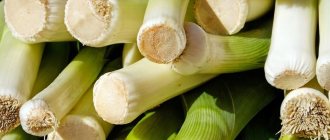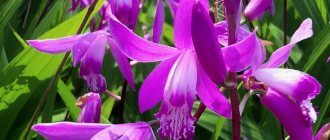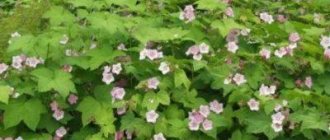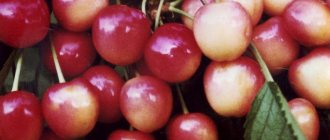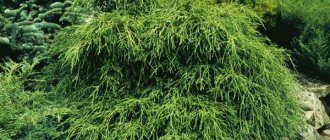Many people have heard about the magic berry, which can prolong longevity and help you lose weight. Goji berries have recently become the most popular delicacy among Internet users, and not only that. Unfortunately, the price of these berries can be very high. But we have great news for you! For the magical goji berry, cultivation on your own plot and at home is now available to everyone! So let's find out what this berry is and what are the nuances in growing and caring for it.
Agricultural technology
Goji Tibetan is a shrub with creeping stems, in the wild reaching a length of 8 m (see photo).
The branches have sharp thorns along their entire length, the leaves are long and narrow, completely covering the stem. Flowering occurs in spring and summer. The fruits are formed at the top of the stems. The berries are bright red in color and resemble cherry tomatoes in appearance. Inside there are small seeds, 8-15 pieces. Goji tastes sweetish with bitterness and slight sourness. The first harvest is harvested in the summer and continues until late autumn. Not only the berries are useful, but also the bark and leaves. In China, goji is popular as a seasoning for cold and hot dishes. Goji berries are watery and difficult to dry. There are about 40 species in total, of which only Chinese and Tibetan goji have healing qualities. Fresh berries in contact with human skin cause severe oxidation and darkening of tissues. The whole plant is poisonous when fresh! The crop is harvested on burlap, spread under the bush, and the ripe fruits are knocked down with a stick.
The climate conditions in central Russia make it possible to grow goji in the country. Rocky soil is suitable for the plant; on fertile soil the plant also grows and reproduces well. Care consists of watering, pruning, harvesting, and preparing for winter.
At home, the plant is provided with:
- draft protection;
- diffused light without direct sunlight;
- 1 month of wintering in January-February with an air temperature of 10C;
- frame for stems;
- pruning and formation of fruit branches;
- alkaline soil;
- watering once a week.
Goji is propagated by seeds and cuttings. In specialized stores you can purchase seeds, seedlings and adult plants, but it is not always possible to grow and maintain fruiting. Growing Tibetan barberry from seeds and seedlings is a labor-intensive, time-consuming process. The plant begins to bloom and bear fruit only in 2-4 years.
Harvesting
Goji berries cannot be picked by hand like raspberries or currants because of the large and sharp thorns. To do this, another method is used: they spread a cloth or film under the bush and knock down the berries with a stick, protecting their hands with clothes with sleeves and gloves.
A bountiful harvest
Then the collected fruits are sorted, removing debris, leaves and twigs, and scattered to dry in the shade under a canopy. After a few days, the stalks are cut off and drying continues, periodically stirring the berries.
A sign of readiness for storage is peeling of the skin, which is easily separated from the fruit. They are poured into a ceramic or glass container and tightly closed with a lid.
Some fresh berries can be frozen for use in drinks and pie fillings.
Goji berries planting and care in the Moscow region
Goji berries
This is a heat-loving plant, so for excellent development of goji, care and cultivation must be optimal or close to it. In northern climates the weather is completely different and effort must be made to grow berries.
Selecting a location
The plant grows very quickly and at the same time has a well-developed root system.
It should be planted either in areas devoid of vegetation, or along supports to create a hedge. It is best to select sunny areas or located in slight shade. In addition, keep in mind that the height of the plant reaches three meters - take care of reliable support.
Temperature, humidity and soil requirements
As was said, dereza is frost-resistant and can withstand temperatures in the range from -26 to +40ºС. There are also no special requirements for humidity. Tolerates drought calmly.
The shrub is not picky about the soil. Favorite substrates are alkaline and neutral. The plant can also be planted in acidic areas, but there it will develop somewhat worse.
The only thing that dereza does not tolerate is stagnation of water. Therefore, you should be very careful when watering and do not plant the plant in areas with rocky substrate.
Watering and fertilizing
Tibetan barberry is watered depending on its age. In the first year, watering should be no more than twice a week. As the plant grows, watering can be done less frequently and adjusted according to the weather and dryness.
Only young growth should be fertilized. For these purposes, humus is used. After growing into an adult plant, there is no need for fertilizing, since the dereza feels great even on very poor lands.
The soil
Good lighting is preferred
Dereza has no special requirements for soil. But still, it is not recommended to grow in rocky and low-lying areas, because... this will slow down the plant's growth. It is preferable to plant goji in areas where the soil is loose, light and has neutral or slightly alkaline acidity. An increased level of acidity will lead to a decrease in the decorativeness of flowering.
What goji is not tolerant of is stagnation of moisture. It is necessary to pay great attention to watering, and also not to place the shrub on rocky soils.
Goji berries, growing from seeds and caring for wolfberry
Duchesnea indica
Goji Berries are popular among many people today. Being a successful marketing ploy, it is advertised as a panacea for all imaginable ailments and an effective destroyer of excess fat deposits.
True, few people know that the newfangled Tibetan miracle berries also grow here, having a more down-to-earth name - common wolfberry, or Berber wolfberry, also called Chinese wolfberry. People call it wolfberry, although this name covers many shrubs that have bright berries, implying their toxicity.
How to grow goji berries yourself
Albuka
Goji berries are actually entirely edible, delicious, and actually have medicinal properties. Perhaps the range of ailments that it cures is not so wide, but today we will talk about how to raise it.
Growing goji berries is easy. The plant loves alkaline and rocky soils, but also thrives on black soil. It tolerates drought more easily than waterlogging. Goji berries are planted on plantations in rows, with an interval of 2–3 m and 1.5–2 m in the row between the plants themselves.
For planting, a hole measuring 50x50x50 cm is prepared. Immediately after planting, goji needs to be supported in the form of a trellis or pergola 2–3 m high, otherwise in the first year the branches will spread across the ground. During the first three years, the crown is formed; for this, 3–5 of the most powerful and longest skeletal branches are selected from the goji bush. Fruiting arms 20–50 cm long are formed on the skeletal shoots. The technology for growing goji berries is very similar to cultivating grapes. Every year, the fruit shoots are pruned, leaving 1–4 fruit buds for each.
If space in the garden is limited, it is wise to form a goji berry bush in the form of a compact tree. To achieve this goal, three-meter metal rods are installed around the bush when planting. The plant is left with a single central conductor, which will serve as a trunk, and the branches are attached to support rods.
The standard should be 1–1.6 m high, then the branches, supported by rods, rise and then, bending, fall to the ground. With this method of formation, we have a vertical standard goji berry tree with hanging fruit branches, a wonderful decoration for the garden all year round.
Goji berries can be propagated by cuttings, directly cutting them and sticking them into the ground, or with a pre-sprouted root system, but the most fruitful method is rooting cuttings. Mid-June is the time when goji bushes are rapidly increasing their green mass, then the young branch bends down and digs in, in a groove previously dug in the ground.
The rooting site is watered, guided by the weather conditions. The branch, without stopping the growing season, begins to take root and may bear fruit. When a strong root system is formed, the goji seedling can be separated from the mother bush and planted in the desired permanent location.
Plants that are not susceptible to attacks by insect pests and are immune to diseases are very rare in nature. Goji also failed to avoid these troubles. Generally, at some point, all plants will show signs of pest or disease damage.
Goji berries are susceptible to attack by aphids, the Colorado potato beetle, which eats flowers and young fruit ovaries, moth caterpillars and other unwanted insects. A goji bush can be protected from unwanted pests without the use of insecticides by spraying the plant with wormwood infusion for prevention.
Regarding goji diseases, manifestations of late blight (Phytophthora) and powdery mildew infestations occur on the leaves. It is easier to protect the plant from diseases if the growing conditions are more natural, that is, it is advisable to grow goji on soils with an alkaline reaction and plant it in time.
|
Goji berries in the country
Country house →
Medicinal plants in the country
→
Goji berries in the country
Goji berries, or “dereza”, have recently become very popular among Russians. Many consider them an effective means for losing weight, while others consider them a storehouse of vitamins and beneficial microelements. In this article we will talk about how to grow this miraculous plant in your own country house.
Goji berries are considered to be the fruits of the Chinese wolfberry (Lycium chinense) and the common (barbary) wolfberry (Lysium barbarum).
Dereza chinensis is a native of the eastern outskirts of the Tibetan plateau of northwestern China, where the first legends about long-lived monks were born.
Common wolfberry grows in numerous territories, such as the Caucasus, central China, Kuban, Central Asia, Ukraine, as well as central Russia.
Dereza belongs to the nightshade family, representing a 3-meter deciduous shrub with a powerful root system. The leaves of the plant are light green on top and bluish on the underside.
Flowering of wolfberry begins in June and continues until October. The flowers have a pleasant aroma and are purple, pink or brownish-violet in color.
As for the berries themselves, they are about 2 cm in length, have an oblong shape, and are orange or red in color. The first fruits will appear in the 3rd year of planting, but may appear earlier.
Growing Goji: propagation, planting, care
Dereza propagates by seeds or vegetatively. Seeds are sown in the spring in a greenhouse without stratification and left there for the winter. After the shoots appear, their tips are pinched so that the bush is dense.
Vegetative propagation is carried out by semi-lignified cuttings, the length of which is about 10 cm.
It is important that there is old wood on the shoot
Rooting occurs quickly if part of the cut is dipped in root and planted in a greenhouse in July. Rooting is also possible on the balcony, if it is insulated but cool.
Common wolfberry can be planted in soil of any composition, but it is important that the place is sunny. It's best to do this in the spring
Keep in mind that dereza does not tolerate stagnant water.
The planting hole should be 40cm. deep and about 60 cm wide. The distance between the two plants is about 2 meters. You need to add 150-200g of superphosphate, 10 kg, to the ground. compost (peat or humus), 30-40 gr. potassium sulfate or wood ash. After planting, the plant needs to be thoroughly watered and mulched with humus or peat.
Caring for goji is not difficult, since the plant is not fussy and can grow even in poor soils. But if you care about the quality of the fruit, you can feed the young plant during the growing season.
You need to water the wolfberry no more than 2 times a week and only after planting, however, the frequency of watering may vary depending on the dryness of the summer.
The plant tolerates pruning well, even with special devices.
Depending on how severe the winters are in your area, goji will need protection from freezing. The plant is covered with spruce branches and snow until spring, or planted in containers and stored in basements.
Goji varieties
Two varieties are suitable for growing in the middle zone - Goji Lhasa or Chinese Goji Lyciet. Chinese Goji has a high yield, and Goji Lhasa begins to bear fruit earlier than other varieties, already in the second year after planting.
On sale you can find many hybrid varieties that reproduce vegetatively, for example NR1 Lifeberry. This variety is characterized by frost resistance and resistance to pests and diseases.
As you can see, growing goji does not require much effort, and you can easily grow it in your summer cottage.
Victoria Goldina, 02/14/2015 Reproduction without an active link is prohibited!
Types and varieties of goji
As we have already mentioned, the common wolfberry, or goji, is a species of the genus. There are two known varieties of this species:
Tibetan wolfberry (Lycium barbarum)
Or Tibetan goji - a high-yielding form of the plant that begins to bloom and bear fruit in the first year after planting. Tibetan goji berries are drop-shaped, up to 2 cm long, sweet, with a noticeable nightshade flavor. Disadvantages are watery fruits and too large seeds.
In the photo: Tibetan wolfberry (Lycium barbarum)
Chinese wolfberry (Lycium chinense)
Or Chinese goji , a taller, stronger plant with elongated, crisp, sweet berries that are easy to eat and easy to dry. Disadvantages: late entry into fruiting and low winter hardiness.
In the photo: Chinese wolfberry (Lycium chinense)
Recently, varieties of common wolfberry have appeared that are of interest to gardeners:
- Photo of Syrian hibiscus
- New Big is an unpretentious, fast-growing and frost-resistant Polish variety that produces its first fruits already in the year of planting. The bright orange berries have a sweet and sour taste;
- Lhasa is an early frost-resistant productive variety of Chinese selection up to 3 m high with arched branches studded with thorns. The plant begins to bear fruit in the second year after planting. The flowers are purple, self-pollinating, the fruits are deep orange, oblong-ovoid, up to 2 cm long and weighing 2-3 g. The pulp is sour-sweet with a barely noticeable bitterness;
- Sugar giant is a spreading, productive and frost-resistant shrub up to 3.5 m high with surprisingly tasty fiery orange berries up to 2.5 cm long. This variety is called Tibetan barberry;
- Sweet Amber is a frost-resistant but heat-loving Chinese variety, bred in 2021, but very quickly gaining popularity. This plant does not cling to supports, but rests on them. This fast-growing bush can reach 2.5 m in height, and its berries become amber-transparent when ripe;
- Superfruit is a lush light-loving shrub up to 3 m high with rich red fruits. Fruiting begins three years after planting.
The use of berries and wolf root in medicine and cooking
Recipe for berry infusion against excess weight and to maintain health: 1 tbsp. l. Pour wolfberry berries into a glass and add hot water, leave to brew for half an hour. Drink half a glass daily for 30 days, 2 times a day.
Recipe for swelling of neurological origin: 1 dessert spoon of dried roots is added to 300 mg of hot water, 20 minutes. simmer over low heat, then leave in a warm place for 40 minutes. The broth is filtered. Take 250 ml orally 5 times a day until swelling and diseases of neurological origin are relieved.
Vitamin soup-decoction to strengthen the body's defense systems with wolfberry berries. Take 100 g of berries, 50 g of cheese (Feta can be used), 2 fresh tomatoes, 1 onion, 2 bell peppers, 100 mg of water, oil and salt to taste (preferably olive oil).
The berries are first soaked in cool water for a quarter of an hour. Grind all ingredients, except cheese, and leave in a cold place for an hour and a half. Place in plates, top with sliced cheese, add some broth or water (if you are preparing a dish for vegetarians), add salt to taste, and add ground pepper, dill and parsley. The dish is ready.
The berries and roots of wolfberry are widely used not only in folk medicine. They are often included in culinary dishes.
Protein shake with wolfberry for recovery as a result of strenuous exercise: prepared a day before intense physical training: 3 tablespoons of berries are poured with a liter of milk (low-fat, preferably 1.5%), covered and set aside in a cool place to infuse.
Next, beat until a homogeneous mass is obtained. The cocktail is ready to drink. You can toss 2 mint or dry cinnamon leaves on the tip of a knife. This will improve and highlight the taste.
The cocktail should be drunk immediately after training, activities or difficult physical work. He will very soon regain his strength, regain his efficiency and strength. The protein value of this wolfberry cocktail is several times higher than that of royal jelly.
Dereza can be dried in a dark place and used in winter instead of pharmaceutical vitamin complexes. You can drink no more than 30 mg per day.
In addition, dried berries are added to the following dishes:
- any porridge,
- casseroles,
- pies,
- cakes,
- in meat dishes.
Wonderful teas and jelly are prepared from them, brewed and consumed instead of ordinary water as a prophylactic against a large number of diseases.
It has been noticed that people who regularly consume these berries feel great and get sick much less. And recently, scientists discovered an element in wolfberry that reduces the risk of developing cancer.
Goji tree cultivation
A hardy crop does not require special conditions or the use of complex growing techniques. The main thing is to choose the right place for planting and you can already consider that half the work is done. When figuring out how to grow goji berries, we note that the fruits can be collected 3-4 years after planting and this can be done very easily: you need to lay a film or any fabric under the tree and simply shake the bush.
Growing goji - soil
Since this crop is hardy, it does not make any special requirements regarding the soil. The shrub develops well on neutral and alkaline soils. It will take root in acidic soil, but it will grow and produce less well. In order to collect goji berries every year, you can grow the plant on rocky soil at your dacha, especially since this will prevent stagnation of water.
When a seedling is planted in open ground, it is recommended to prepare a soil mixture: combine fermented humus, coarse river sand and garden soil in equal proportions. To increase fertility, it is necessary to add a number of fertilizers: 200-300 g of superphosphate and 1 liter of wood ash. Another option is to pour 300 g of potassium sulfate under each bush.
Goji Shrub Growing Temperature
Since in nature the plant is found in mountainous areas, low temperatures are not scary for it. It has already been said that the seedling takes root at a reduced temperature. Growing goji plants in open ground should begin in the spring, since the young plants may not survive the winter. An adult shrub feels normal at -15°C. It is also not afraid of heat; the main thing is not to forget about watering in case of severe drought.
Magic tea
Useful for those who want to lose weight
Another option for consuming goji berries is making tea, which will be useful for overall strengthening of the body. It is especially suitable for those who want to lose weight.
Recipe:
- The brewing container steams well
- Place 1 tsp in it. dried fruits. Everything is filled with hot water (80-900C). From boiling water, many useful microelements that contribute to weight loss may disappear
- In order for the berries to steam well, the dishes need to be covered and left for a while.
For consumption, the drink is not sweetened with anything, not even honey. It is possible to add other ingredients, for example, dried raspberries, cranberries or blueberries. This will only enrich the tea with amino acids, which will help in getting rid of excess fat deposits. The berries are thrown away after brewing because... they no longer have anything useful.
Despite its exotic origin, to enjoy goji - its beauty in your own territory and the healing fruits for health, prepared independently for the winter - you do not need to visit distant countries and spend a lot of money on its purchase. Compliance with the basic principles of planting and care will give everyone the opportunity to have this wonderful plant in their garden and achieve good productivity from it.
Video: Goji berries. Benefits, cultivation, care
GOJI BERRIES. Benefits, cultivation, care
Goji - An Eastern miracle in our garden: planting and care in open ground in the Moscow region and Siberia. Useful properties | (Photo and video)
Video: Goji berry (dereza). Growing
Reproduction
Three methods are used for propagation.
Seminal
Seeds are taken from pre-dried berries.
To obtain seed, you should take dry fruits, soak them in water and, when they soften, remove the seeds. In order for them to germinate well, they need to be kept in a growth stimulator. Afterwards, sowing is carried out in a container with a mixture of ordinary soil in a ratio of 1:2, deepening it into the substrate by 2-3 mm. To maintain the necessary conditions for germination, the container is covered with film and sent to a warm place, inaccessible to light. When the sprouts hatch, the box is taken out into the light and protected from cold and drafts. Watering is done from a spray bottle.
After a week, the film can be removed, and when 3-4 leaves are formed, pick (transfer) the seedlings into separate pots (deep).
Planting seedlings
This option is acceptable if you managed to buy goji seedlings grown at home, or you purchased planting material from your own hands.
With this method, two weeks before planting, holes should be made 40-50 cm in size. If for the southern regions the “harvesting” is done in the fall, then for colder regions - in the spring. This will allow the plants to withstand frost well.
Coarse sand is poured into each hole and half filled with a substrate consisting of humus and fertile soil, 8 kg each. 30 g of potassium sulfate (can be replaced with a glass), 0.15 kg of double superphosphate are also added there, mixed directly in the hole and the seedling is planted, sprinkled with fertile soil, and then watered.
The tree trunk circle must be mulched using humus or peat.
Cuttings
Now we’ll tell you how to grow goji from cuttings. Cuttings of 10-12 cm each are cut from an adult plant. Then they are placed in a root-forming solution and planted for rooting in a constructed greenhouse and placed in a warm place. It is best to plant the material in late July - early August. In the spring, the root will grow enough to plant goji in open ground. Caring for a young plant is not much different from an adult one.
Growing goji at home, diseases and pests
The shrub is not only easy to care for, but also resistant to various diseases and pests. Young shoots can rarely be damaged by aphids, and the Colorado potato beetle can be visible on flowers and young ovaries. When growing goji berries during rainy periods, it may appear. You can cope with pests by spraying with wormwood infusion. Diseases, for example, appear due to poor care or selection of unsuitable soil. As a preventive measure, chemical treatment is not necessary.
Tibetan barberry is a plant that has recently become incredibly popular. Goji berries have a strengthening effect on the body, help get rid of cellulite and improve vision; each berry contains a rich set of vitamins, minerals and trace elements of natural origin. The natural habitat of Tibetan barberry is the mountainous regions of Tibet, from where the berry is supplied in limited quantities to different countries. In this article you will find information on how to grow goji berries yourself, on the selection and processing of seeds for planting in the country.
Useful bait (Russian name for goji) promises relief from a number of diseases.
In Tibet, they have long learned to use the fruits of wolfberry: local shamans prepared tinctures and mixtures that healed various diseases. For several centuries, the secret of this plant was successfully hidden, but now goji berries can be bought for the prevention and treatment of diseases in any country.
Dereza belongs to the Solanaceae family - a tall shrub up to 2 meters in height, has tangled flexible shoots with thorns, blooms with small star-shaped, funnel-shaped lilac flowers with green veins. During flowering, dereza attracts bees - the plant is an ideal honey plant.
A huge number of species of this shrub are distributed throughout the globe (about 80 species are known): African wolfberry - in Africa; Shanghai barberry - in China; Lycium is found in the foothills of the Caucasus. The plant develops well on slightly salted soils; after flowering, which lasts the second half of summer, the fruits ripen - red, yellow or orange berries. There are varieties with purple berries.
In Russia, dereza was known under the names: zamanikh (zamanikha), devil's lashes, tkenna (in the Caucasus).
Only goji berries from Tibet have medicinal properties.
What are the beneficial properties of goji berries?
Treatment, weight loss
Now we propose to discuss the beneficial properties of this magical berry, which is often called “the cure for a thousand diseases.” It is indeed very rich in beneficial vitamins and a number of microelements. Goji berry will help cope with insomnia and is recommended for use for diabetes and anemia. This berry has become widely known because of its properties that help in weight loss. Even in China, it has been included in every diet since ancient times. Goji berries do not contain carbohydrates or starch. The beneficial substances of the berry effectively help control appetite, and also quickly burn excess weight and help develop muscle mass. In addition, goji berries help deliver calcium to the body, and this, in turn, strengthens bones, nails and teeth. In addition to all of the above, it has already been proven that goji berries help maintain beauty and youth; consuming them activates the anti-aging effect. Since berries contain a lot of proteins, they also have a tonic property. But do not forget that berries serve only as an aid, but are in no way a “magic pill”. They will only help with a complex effect on the body through sports and proper nutrition.
Goji berries cultivation
Growing wolfberry from seeds
This plant has many names, in Russia the most common is zamanika.
To plant an amazing plant with medicinal berries on your plot, you need to grow a sufficient number of seedlings to ensure a harvest of wolfberry in quantities sufficient to treat or prevent diseases. The undemanding plant takes root well in summer cottages in the Moscow region. Caring for plants is not anything special; wolfberry tolerates low-fertility soils of moderate salinity.
In nature, wolfberry (Tibetan barberry) reproduces by self-sowing - the berries, falling to the ground, germinate, forming new thickets.
At home, if it is impossible to take cuttings from adult plants, the shrub will have to be grown from seeds, carefully observing the agricultural techniques for growing this plant. Wolf seeds for planting in the country can be purchased in specialized stores, or you can use goji berries for propagation.
Seeds are planted in winter, around mid-February. Seeds freed from berries are soaked in a solution of growth stimulants; excellent results were noted when using Epin, Zircon and Humate. The seeds are kept in the solution for about 2 hours, after which they are immediately sown in containers filled with a mixture of peat and loam. For better seed germination, the bowl must be covered with glass or plastic film, creating greenhouse conditions.
The first shoots begin to appear approximately 2 weeks after sowing; at this time, weak shoots must be protected from direct sunlight. Young seedlings must be picked at the 2-3 leaf stage, and each plant should be transplanted into a separate pot.
Dereza quickly grows after transplantation, so before planting in open ground, it may be necessary to transfer it again to a larger container. It is useful to pinch out the growing point of young plants - this operation will allow you to obtain seedlings with a well-developed crown.
Bushes can be planted in a permanent location in warm weather, when there is no danger of morning frosts.
AND ONLY WITH THE HELP OF “GOJI BERRIES”!
And everyone, like crazy, rushed to consume these miraculous fruits in incredible quantities. The media vied with each other about miraculous cures using goji berries. Incredible stories of recovery of hopeless patients were passed on from mouth to mouth. There was even talk that based on these berries, a means of extending life by several centuries had been created! It is supposedly based on the recipe of the ancient Incas, who possessed the secret of immortality using the same goji berry.
I thought - all this has already happened: “Kremlin* tablets, mumiyo, sprouted wheat grains with wild bee honey, various dietary supplements... Today all these newfangled products have received the loud name “superfoods”. And enterprising people make very good money from them.
EVERYTHING YOU NEED FOR THIS ARTICLE IS HERE >>>
But the topic interested me very much. Once it’s a berry, it means it can be grown! And I decided to find out more about this plant.
GOJI BERRIES. How to grow from seeds at home
We also recommend reading: Growing goji (photo) in Russia - care
a brief description of
Seedlings can be purchased at the store or grown yourself. Goji seeds sprout quickly enough and do not need to be processed.
Soak them in the solution before planting or and wait a couple of hours. choose a medium-loose one, preferably neutral.
Did you know? Tibetan monks still throw goji berries into wells from which they drink water. They believe in their healing and rejuvenating properties, which are the key to their well-being and longevity.
For seedlings, choose a well-lit, warm place where it is easy to maintain the required humidity and temperature. Avoid drafts or overheating from various heat sources.
When the seedlings have sprouted, place them in a slightly dark place, and after a few green leaves appear, you can plant them in different pots about 7 cm deep. This will make it easier for the roots because of their rapid growth.
When the seedling is ready to be planted in the ground, properly prepare a hole for it, as described above. When planting, bury the finished bush, water well and...
If you grow goji berries from seeds, they will bloom in the second year, but produce fruit in the third or fourth.
It is best to plant seedlings in the spring when the air temperature is above 20 ° C; this is not recommended in the fall, since there is a high risk of the plant dying in winter.
Did you know? In China, goji berries are used as a waste-free plant. In certain doses and proportions, their leaves, bark, and berries can be effectively used to prepare medicinal drinks and preparations.
Taking into account the climatic conditions of the Moscow region, it is recommended to plant the bush first in, in which it should be kept for 6 months.
In the first months after planting, very slow development of the seedling is observed. Externally, the plant is similar to a tomato bush, but gradually grows faster, and the height is already about 80 cm.
As it develops, green leaves appear and flowering begins in the form of small purple and white flowers that last until the first frost.
Goji bush description
The fruit plant belongs to the Solanaceae family. It is also called “dereza”. In nature, the shrub grows in China, Tibet and the Himalayas. If you know the growing conditions, then goji can be planted in your garden or at home in a pot.
- It can reach a height of 3.5 m, but if you prune it, you can make it grow wider. An experienced gardener manages to create a standard look.
- There are thin spines on the surface of the branches, and the leaves are elliptical in shape. The flowers look like bells and are purple in color.
- The berries are oval in shape and colored scarlet-red. They reach about 12 mm in length. Goji bears fruit, the care and cultivation of which is carried out according to the requirements, either from May to September or from July to October. During this time, up to 13 harvests can be collected, but the most valuable are the fruits picked in August.
Agricultural technology for outdoor care
Dereza blooms with inconspicuous lilac flowers.
Tibetan barberry (not to be confused with real barberry, which belongs to a completely different botanical species) is a very undemanding plant that can tolerate short-term droughts and tolerate poor and saline soils, but to obtain a rich harvest of berries, it is necessary to provide the dereza with proper care.
Soils with a slightly acidic reaction are suitable for planting wolfberry, but growing shrubs is possible on any soil. The plant develops best in open areas, because the size of the average bush is quite large. You should not choose shady places with high groundwater levels for placing plants - Tibetan barberry is afraid of getting wet and develops better in sunny places.
It is best to plant bushes in open ground in the spring, because during autumn planting, the plant can easily freeze. Without shelter, the bushes winter well at temperatures down to -15C in the southern regions of our country. When the temperature drops in winter to -25C, it is necessary to cover the crop, but even such actions cannot guarantee that the wolfberry will overwinter without frostbite. Sometimes bushes that are not covered enough freeze out to the level of the root collar, but in the spring they successfully grow back.
Seat
Seedlings are planted in separate holes, which are located at a distance of up to 2 meters from each other. The dimensions of the pit are 50x50x40 (for small seedlings), 60x60x40 - for adult bushes. The soil taken out of the pit is mixed with peat, humus, wood ash and superphosphate in a ratio (weight in kg) of 5: 5: 0.04: 0.2. The root collar is slightly deepened when planting. The tree trunk circle should be thoroughly watered and mulched on top with peat chips or humus.
Dereza care
Small wolfberry seedlings, picked into different pots.
It is very easy to care for wolfberry bushes:
Watering - the plant cannot be flooded, so watering is carried out taking into account summer temperatures, taking into account moisture due to precipitation. In dry weather, plants can be watered 2 times a week. Fertilizing – soils of average fertility are ideal for growing plants
Fertilizers are applied in the first half of summer after planting the plant in open ground; Tibetan barberry does not need further fertilizing. Wintering - there are two ways to preserve plants in winter: constructing a reliable shelter, the second way is to preserve the dug out bushes in a greenhouse, planting them in the ground every spring. Both methods have their pros and cons. With winter shelter, there is no guarantee that the plant will not freeze in severe frosts, but it will not receive additional stress during replanting. Pruning - Goji bushes tolerate shaping haircuts and drastic pruning well. Plants quickly grow green mass, bloom well on new branches and bear fruit productively. Protection from pests - Tibetan barberry is highly resistant to diseases; pests also rarely visit this plant. Sometimes aphids can harm wolfberry seedlings, but this pest does not damage adult plants. In rainy weather, powdery mildew may appear on young plants. Bushes should be treated with phytoncides.
Wolf bushes dug up for the winter may become diseased in greenhouse conditions, which will not allow them to produce good growth when transplanted into open ground. Annual transplants lead to a shift in the timing of crop ripening closer to autumn, thereby reducing the productivity of the bushes.
Proper care of wolfberry bushes guarantees a high yield of berries, which have high preventive and healing properties.
Aftercare
Caring for the plant is not particularly difficult.
In dry summers, wolfberry must be watered regularly, 1-2 times a week: the soil should always be slightly moist. If the weather, on the contrary, is rainy, watering is not required. In mid-July, it is worth applying complex mineral fertilizer, and it is also necessary to regularly remove weeds.
If the bush has grown greatly or it is necessary to give it a certain, more accurate shape, it is necessary to prune it. It can be done with any tool, as long as it is sharp enough. Typically, gardeners remove three-year-old branches, since they practically do not bear fruit and only interfere with young shoots.
The plant has good frost resistance, easily survives cold down to -20-25 degrees and does not need special wintering. But it is still recommended to cover the bush for the winter so as not to freeze it.
Spruce branches or simple fabric tied on top are suitable for this. If the plant “lives” in a pot and was simply taken outside, it can be put in the basement or other cool place (the temperature should not be lower than +10 degrees).
If this is not part of the gardener’s plans, it is necessary to tie up the bushes immediately upon planting. The simplest option is to drive a support up to 1.5 meters high near the bush and tie branches to it. When the bush reaches this height, its top is cut off to stop growth. At a height of 1-1.5 meters, the side shoots are also thinned out so that the bush does not “fall apart”.
Botanical certificate
The question immediately arises: where do goji berries grow and what are they?
The plant is a deciduous shrub belonging to the nightshade family. The plant is also called wolfberry (popularly, although it has nothing in common with them), red medlar, Chinese wolfberry, Chinese wolfberry, common wolfberry, wolfberry, Tibetan barberry. Homeland: Ningxia Hui (Tibet), China. The distribution area covers Southeast and Central Asia, the Caucasus, Primorye, central Russia, and Ukraine. In adulthood, the height of the plant reaches 3 m, and the crown is 6 m in diameter (photos of the goji bush are presented). The branches are drooping and prickly, with small foliage, colored light green above and bluish below. The root is very powerful, growing into the ground, and not on its surface.
Flowering begins in June and continues until October with the blooming of purple, pink, brown-violet buds with a pleasant aroma.
At the end of flowering, oblong berries of purplish-red or orange color are formed.
How to care
The most important care for goji berries is in the first year of their life.
It is during this period that the plant is most vulnerable and is susceptible to various environmental threats.
Watering
The first two years are crucial for a plant. Therefore, treat this responsibly.
You can use covering the trunks with a special film during prolonged frosts or rains. In adulthood, it is resistant to both drought and rainfall. Additionally, it is only necessary during dry periods if the plant is located in direct sunlight.
Top dressing
In order to grow a healthy one, fertilize the seedlings before planting them. After this, annually in the spring add compost and special compost with a high content of potassium, nitrogen and phosphorus.
If you are a beginner gardener, you can purchase ready-made mixtures at a specialty store. You can make compost and other mineral supplements yourself.
Trimming
The growth of wolfberry occurs at a fairly rapid pace, and soon the plant can reach a height of 3–4 meters. Bush pruning is carried out in order to increase productivity and improve appearance.
To do this, you need to remove excess skeletal branches, leaving the strongest ones. The formation of fruiting shoulders occurs on them, and then fruiting branches form on the shoulders themselves.
To stimulate their growth, prune the branches annually, leaving no more than four buds on each. It will also be useful to build a special support structure for the bush so that its shoots do not spread along the ground.
In principle, light frosting is not particularly dangerous for a plant, since it can quickly recover with the help of young shoots.
If you are still afraid of frost damage to the bush, plant the plant in deep containers and store them in the basement until spring.
Many people have heard about the beneficial properties of goji berries, which are used in Asian countries to treat various diseases and lose weight. Many people like their unusual taste, which is difficult to compare with anything else. To have goji on your site, care and cultivation must be carried out according to all the rules.
Preparing for winter
Goji planting
Despite the fact that there are varieties that can tolerate cold weather (-15...-250C), to be on the safe side, it is still worth preparing them for the upcoming low temperatures. To do this, in the fall the bush is covered with spruce branches. This will protect it from freezing if there is little snow falling in winter.
In the autumn, varieties that are not resistant to frost are dug up along with the soil and transplanted into containers of the required size. Store the shrub in the basement with stable, slightly above-zero temperatures.
Application and storage
Collected fruits should be stored in a dry, dark place. If an infusion is being prepared, it should be kept only in a cool place and for no more than 2 days.
Berries are used not only for weight loss, but also as an ingredient in the preparation of wines, fruit purees, desserts, soups, baked goods, yoghurts, tea, juices, and cereals. The seeds are used to produce oil. Fresh berries have a nightshade note to their taste. But as soon as the fruits are frozen or dried, the taste disappears, and the berries acquire a taste similar to dried apricots.
In the garden, dereza is mainly planted to obtain a useful harvest, as well as vegetable hedges. The plant is unpretentious and will not die if you do not water or apply fertilizer. But, when planning to plant goji berries on your plot, you should consider all the varieties in advance and choose the most suitable ones.
The berries are also widely used in medicine. So, they are taken for: back pain, diabetes, insomnia, anemia, obesity, excess cholesterol, problems with adenoids, vision problems, athletes thus restore their strength, etc.
As you can see, although goji berries are an exotic shrub, you don’t need to go to overseas countries or buy them at an incredible price. It is enough to follow some nuances, and you can easily grow a plant on your site and reap quite a considerable harvest.
Goji in the garden - video
The climatic conditions of the Moscow region are ideal for growing wolfberry or, as this plant is commonly called throughout the world,. Nowadays it’s hard to find a person who hasn’t heard of the miracle goji berries. They help not only with weight loss, but are also an excellent healer for many diseases and contain a large amount of useful microelements. And the most important thing is that you don’t need to look for them in stores, but you can grow them yourself and pamper your body all year round.
The main myths about goji berries
From 2006 to 2007, a passionate campaign for the nutritional and nutritional value of goji berries was formed. Marketers and nutritionists excitedly talked about the healing properties of the product and created an artificially tense situation in the market. Every second follower of a healthy diet wanted to get a handful of magic berries, despite the cost (and it remains high today). Goji invaded the United States and the European Union and continued to develop rapidly.
Also in 2006, the US Department of Food and Drug Administration found that the benefits of goji are far-fetched, and in some cases the berries are harmful to the human body. The law prohibited the advertising of goji as a medicinal product and the excitement around the new product died down. Subsequent studies have proven and substantiated the criticisms of the berries, and their juice has not been found safe and effective under reference conditions.
Berries and ascorbic acid
The entire advertising campaign was based on one statement: “goji berries have a high content of vitamin C, which is incomparable to citrus fruits.” Scientists, having analyzed the market and realized the cause of the craze, decided to start by testing the product for ascorbic acid.
Clinical studies have proven that the vitamin C content is significantly inferior to citrus fruits.
The amount of ascorbic acid (vitamin C) in a red apple is 13 times greater than in goji berries.
Scientists have refuted the marketing postulate, but sales have not fallen. Even direct evidence that Australian plums are several times healthier than goji plums has not influenced buyers. Why? Because advertisers and manufacturers, hungry for profit, had two spare cards in the lining of their sleeves.
Berry juice
Manufacturers claimed (and claim) that goji juice is the most powerful antioxidant that heals everything. In January 2007, a consumer protection investigation took place during which goji juice was subjected to 23 laboratory tests. 22 out of 23 points turned out to be false, and claims about the magical properties of the product are nothing more than falsification. It turned out that the juice is an absolutely useless product, and in some cases it can even be dangerous. The public began to come to their senses, the excitement subsided along with the percentage of sales of goji berries.
Berries and the risk of cancer
The last trump card in the hands of manufacturers is cancer prevention. The study was carried out by the US National Institutes of Health and the National Cancer Institute. The verdict was: no pharmaceutical product can provide 100% effectiveness, as goji berry manufacturers claim. Herbal ingredients cannot be more effective than traditional medications. In addition, scientists claim that berries could not cure any disease in the world. A preventive effect that would minimize the risk of developing cancer or any other pathology has also not been identified.
Use of wolfberry in medicine
Decoctions are prepared from wolfberry berries. To do this, 30 - 40 g of dry berries are poured into 1.5 cups of boiling water and simmered over low heat for 1/6 of an hour, removed from the stove and left for 60 minutes, then filtered. The broth should be added with boiled water so that its amount is equal to the original volume of liquid. Should be taken three times a day, 100 mg. This decoction helps well with neurasthenia and can increase potency.
In a similar way, a decoction is prepared from the bark of wolfberry roots. This decoction is recommended for fever.
Pharmacies sell hermetically sealed dried fruits of wolfberry.
Decoctions are prepared from wolfberry berries
Pruning and wintering
The bush needs regular pruning. In the first years of growth, 3-6 of the strongest branches are planned. They are taken as a basis and a haircut is carried out around them. Then shoots capable of bearing fruit will begin to form on these main skeletal branches.
If the dereza is grown for decorative purposes, then choose one main shoot, drive in a long peg, and then carry out a “haircut”, trying to form a tree. The procedure is done as soon as numerous fruiting shoots appear and the total height of the plant exceeds 1.2 m.
To prevent freezing of the root system in winter, the bush should be hilled up to 10-15 cm. The branches are protected with non-woven material (for example, agrofibre, lutrasil), folded in several layers, or with burlap. You can play it safe by additionally throwing spruce branches over the planting, and, as soon as the snow falls, make large snowdrifts.
Mulching
Goji seedlings
To preserve moisture around the seedling and its safety from possible sudden cold snaps, it is recommended to lay mulching material (peat, sawdust) in the tree trunk area for the first year. The thickness of the mulch layer is 5-7 cm.
For cold areas, the soil is sprinkled for the winter period. This will help prevent hypothermia.

